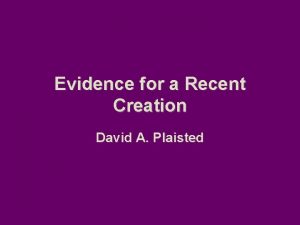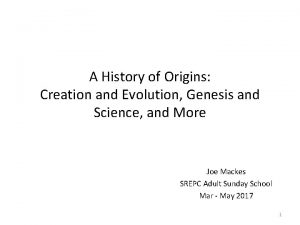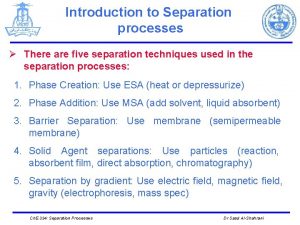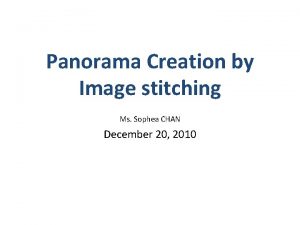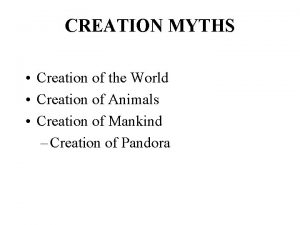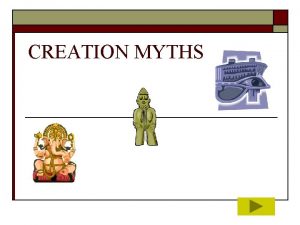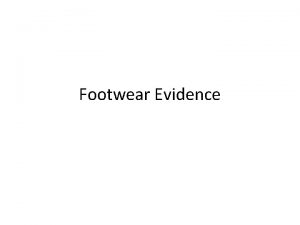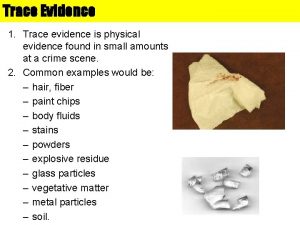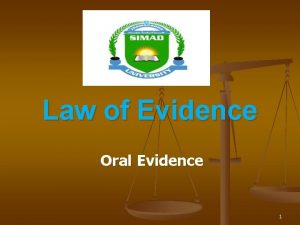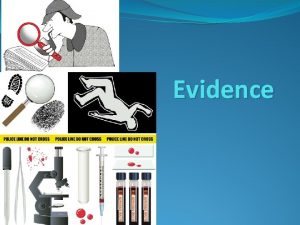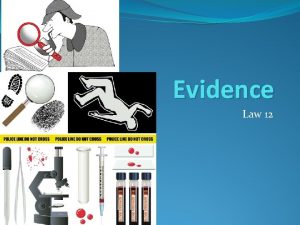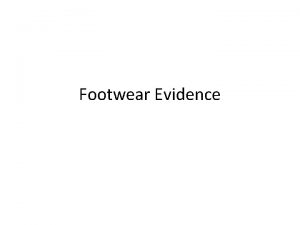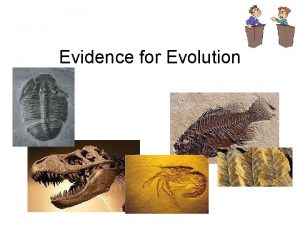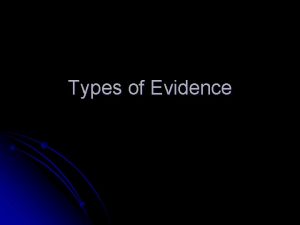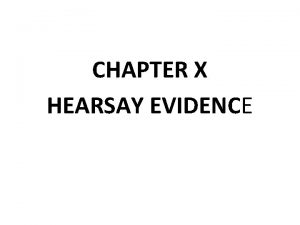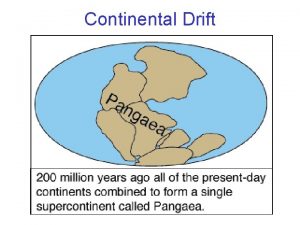Evidence for a Recent Creation David A Plaisted































































![Giem [18] reviewed the literature and tabulated about seventy reported AMS measurements of 14 Giem [18] reviewed the literature and tabulated about seventy reported AMS measurements of 14](https://slidetodoc.com/presentation_image/2087e9a127b61372964b736b3fbb69c1/image-64.jpg)






























































- Slides: 126

Evidence for a Recent Creation David A. Plaisted

Evidences for a Worldwide Flood • Sedimentary deposits unlike any produced today • Uniform sedimentary layers extending hundreds of miles in all directions • Some thick and extensive sedimentary layers have remarkable purity • Limestone layers, hundreds of feet thick, are sometimes found • Lack of erosion between the layers “Did millions of years fly by with no discernible effect? ” • One would think in even a thousand years there would be roots or worm burrows or stream erosion or clam tracks. Instead, most of the interfaces are sharply defined.

• 257 Flood legends • Evidences of catastrophe in the geological column: Contemporary geologists and paleontologists now generally accept catastrophe as a 'way of life' although they may avoid the word catastrophe • There are numerous examples of sediments composed of many thin laminae that were laid down rapidly in short periods of time, even in minutes • Some geologists estimate that over 40 percent of the sediments laid down in the past came from turbidity currents, which are associated with rapid deposition of sediment

• FOSSILS! Dead animals and plants quickly decay, are eaten, or are destroyed by the elements • Fossil caves, fissures, mass burial sites, and sedimentary strata discovered in Europe and America are jammed with masses of mixed bones of many sorts of animals from widely separated and differing climatic zones • Fossils often display evidence of terror and struggle • British paleontologist Derek V. Ager believes that most fossils were produced in short periods of catastrophic activity separated by long periods of relative quiet

Problems • Animal tracks • Nests of dinosaur eggs • There is some evidence they were produced under water • Or they may have been produced after the flood when the crust of the earth was very soft and the rate of erosion was very high

Rapid burial?

Is the present really key to the past? The Grand Canyon Mount St Helens

Evolution Predictions: l Gradual change Evolutionary “tree” “One hundred and twenty years of paleontological research later, it has become abundantly clear that the fossil record will not confirm this part of Darwin’s predictions. Nor is the problem a miserably poor record. The fossil record simply shows that this prediction is wrong. ” – Eldredge & Tattersall, The Myths of Human Evolution, 1982, p 45 -46

Evolution Predictions: l Gradual change l Simple to complex Evolutionary “tree” “The old Darwinian view of evolution as a ladder of more and more efficient forms leading up to the present is not borne out by the evidence. ” - N. D. Newell, Why Scientists believe in Evolution, 1984, p 10, American Geological Institute pamphlet

Evolution Predictions: l Gradual change l Simple to complex l Clear-cut lineages Evolutionary “tree” “The known fossil record fails to document a single example of phyletic evolution accomplishing a major morphologic transition and hence offers no evidence that a gradualistic model can be valid. ” - Steven M. Stanley, Macroevolution: Pattern and Process. 1979

Evolution Predictions: l Gradual change l Simple to complex Clear-cut lineages l Identifiable common ancestors l Evolutionary “tree” “The gaps in the record are real, however. The absence of a record of any important branching is quite phenomenal” – R. Wesson, Beyond Natural Selection, 1991, p 45

Creation Predictions: l Sudden appearance Creationist “Orchard” “One of the most difficult problems in evolutionary paleontology has been the almost abrupt appearance of the major animal groups” - A. G. Fisher, Grolier Multimedia Encyclopedia, 1998, fossil section

Creation Predictions: Sudden appearance l Fully developed l Creationist “Orchard” “…the Cambrian strata of rocks, vintage about 600 million years, are the oldest in which we find most of the major invertebrate groups. And we find many of them already in an advanced state of evolution, the very first time they appear. It is as though they were just planted there, without any evolutionary history. Needless to say, this appearance of sudden planting has delighted creationists” – Richard Dawkins, The Blind Watchmaker, 1987, p 229

Creation Predictions: Sudden appearance l Fully developed l l Stasis (little change over time) Creationist “Orchard” “The observation that species are amazingly conservative and static entities throughout long periods of time has all the qualities of the emperors’ new clothes: everyone knew it but preferred to ignore it. Paleontologists, faced with a recalcitrant record obstinately refusing to yield Darwin’s predicted pattern, simply looked the other way” - Eldredge and Tattersall, The Myths of Human Evolution, 1982, p 45 -46

Vertebrates in the Cambrian! “The emergence of such a sophisticated creature at so early a date show that modern life forms burst on the scene suddenly…Neo. Darwinism cannot account for the sudden emergence of so many new genetic forms” - Prof. Jun-Yuan Chen, quoted in ‘A Little Fish Challenges A Giant Of Science’ - The Boston Globe, May 30, 2000

Punctuated Equilibrium • Many biologists believe that evolution happened in spurts, too fast to be seen in the fossil record • Why would one think so unless one believed in evolution in the first place?


Complex Invertebrates • Complex invertebrates make up the vast majority of the fossil record, roughly 95%. We have cataloged literally millions of different species of these very complex creatures, and we have entire fossils, not just pieces here and there. In this rich and virtually complete portion of the fossil record, there is not a single sign of evolution, whatsoever!!!2

Plants, Algae, and Insects • The remaining 5% consists mostly of plants & algae, where again we find no fossil evidence of evolution, whatsoever. 3 In the small portion that includes insects, again we find no fossil evidence of evolution, whatsoever. 4. • The transformation from invertebrate to vertebrate would have been a major event in the earth’s evolutionary history. Yet the fossil record does not leave a single shred of evidence for this enormous transformation!5.

Fish and Land Vertebrates • So all that is left is a sliver of a corner of the fossil record, the vertebrates. The bulk of this sliver is made up of fish, where we again find no sign of evolution whatsoever. 5 A small remainder of this miniscule sliver is left for the land-dwelling vertebrates. Of the land-dwelling vertebrate species unearthed, 95% are represented by a bone or less 1. Yet this is where the evolutionist concentrates all his efforts to "show" to his audience that "the fossil record supports evolution"!

• In the widely used college undergraduate textbook “Evolutionary Biology” (3 rd Ed. 1998), author Douglas Futuyma does not list one single transitional leading up to the complex invertebrates (see chapter 6 in particular, “Evolving Lineages in the Fossil Record”). All his transitional examples spanning orders or classes are vertebrates! His only mention of the "evolution" of the complex invertebrates is a brief snippet on the changes in rib numbers on trilobites! This of course is nothing more than small-scale variation, or micro-evolution. Also see “Invertebrate Beginnings”, Paleobiology, 6: 365 -70, R. D. Barnes, 1980.

• Botanists at the University of Nebraska recently wrote: “The mystery of the origin of flowering plants was and still is complicated by the lack of any obvious candidates for next-of-kin for the group. ” See The Abominable Mystery Of The First Flowers: Clues from Nebraska and Kansas, by M. R. Bolick and R. K. Pabian.

• The words of widely recognized evolutionist botanist E. J. H. Corner of Cambridge University still ring true 40 years after he wrote them: “But I still think that, to the unprejudiced, the fossil record of plants is in favor of special creation. . . Can you imaging how an orchid, a duck weed, and a palm have come from the same ancestry, and have we any evidence for this assumption? The evolutionist must be prepared with an answer, but I think that most would break down before an inquisition” - Contemporary Botanical Thought. , Mac. Leod, A. M. and Cobley, L. S. (eds) 1961. Chicago: Quadrangle Books, p 97.

• The 2001 Encyclopædia Britannica Online states: “No fossils have yet been found from the Late Devonian or Early Carboniferous periods, when the key characters of present-day insects are believed to have evolved; thus, early evolution must be inferred from the morphology of extant insects. ”- Insect: Insect Fossil Record, Encyclopædia Britannica Online 2001. <http: //members. eb. com/bol/topic? eu=108350&s ctn=35>

• The lack of fossils intermediate between invertebrate and vertebrate is well documented in the scientific literature. Carl Zimmer in Science magazine recently wrote: “But the record provides few clues to help resolve this contradiction, because there are no animal fossils that old and no examples of an intermediate species. ”(‘In Search Of Vertebrate Origins: Beyond Brain And Bone’, Science, March 3, 2000 [emphasis added]). • “The extensive marine beds of the Silurian and those of the Ordovician are essentially void of vertebrate history”- “Fish", Encyclopædia Britannica Online 2001[emphasis added]

Dinosaurs Evolutionists cannot offer a single example of an ancestor of the dinosaurs. See figure “Dinosaur Family Tree, ” from Encyclopædia Britannica Online. Source for some slides: http: //www. evolutionfairytale. com/articles_de bates/fossil_illusion. htm

A whale of a tale “Among the important recent discoveries is Pakicetus, known from a skull found in a riverine” Douglas Futuyma, Evolutionary Biology, 1998, p 196 Pakicetus

Piltdown Man Brown = actual bones; White = portion artist has filled in with clay • Discovered in 1910 • Exposed as fraud in 1953

The Evolution Definition Shell Game Macro vrs Micro Evolution Unlimited Variation Limited Variation

The “Evolution” of Resistant Bacteria There are three primary ways drug resistance occurs: 1. Some resistant strains already existed 2. Mutation caused strain to become resistant (loss of information) 3. Some germs directly transfer their resistance to others

• Earth: – Precise distance from Sun – Precise mass to retain atmosphere and ocean – Ideal axis tilt, orbit, spin rate, and radius • Ideal mass and color of Sun • Moon is precise distance and size to stabilize tilt and produce tides • Jupiter’s distance and mass maintain earth’s orbit and sweep up comets and asteroids • Ideal Carbon dioxide and oxygen/nitrogen ratios • The charge and masses of fundamental particles have remarkably tight tolerances; any small change renders life impossible. • MANY MORE FINE-TUNED PARAMETERS!

DNA – Language of Life




Virtually every ancient culture has dragon legends From World Book Encyclopedia: “The dragons of legend are strangely like actual creatures that have lived in the past. They are much like the great reptiles [dinosaurs] which inhabited the earth long before man was supposed to have appeared on earth. Dragons were generally evil and destructive. Every country had them in its mythology. ” 1 1 – 1973 World Book Encyclopedia, p 265

Ceremonial Burial Stones from Peruvian Tombs (c. a. 500 -1500 AD) What kind of Dino does this look like?

Dinosaur Figurines from Mexico (from the Pre-classical Chupicuaro Culture 800 BC – 200 AD) What kind of Dino does this look like?









2 Peter 3: 3 -6 knowing this first: that scoffers will come in the last days, walking according to their own lusts, and saying, "Where is the promise of His coming? For since the fathers fell asleep, all things continue as they were from the beginning of creation. " For this they willfully forget: that by the word of God the heavens were of old, and the earth standing out of water and in the water, by which the world that then existed perished, being flooded with water.

Psalms 118: 8 It is better to trust in the LORD Than to put confidence in man.

Evidence for accelerated decay • • Helium retention in zircons Recent Carbon 14 dates Radiation and accelerated decay Evidence of accelerated mutation rate Evidence of a nearby supernova Lack of objects in the Kuiper belt Correlation between surface heat flow and the radioactivity of surface rocks

Many lines of evidence are beginning to fit together into a consistent picture. How much evidence is necessary before a paradigm shift occurs?

Creationists now feel that billions of years worth of radioactive decay has occurred on earth, giving old isotopic dates, but this decay took place in only a few thousand years.

• These results suggest that the earth was created a six or seven thousand years ago and life was created soon thereafter • These results do not constrain the age of the universe • Many creationists believe the universe is also young • Some young earth creationists believe the universe is old

Alpha Decay


ZIRCONS

HELIUM DIFFUSION RATES SUPPORT ACCELERATED NUCLEAR DECAY D. RUSSELL HUMPHREYS, STEVEN A. AUSTIN, JOHN R. BAUMGARDNER, ANDREW A. SNELLING International Conference on Creationism Geneva College, Beaver Falls, PA August 4 -9, 2003

Two decades ago, Robert Gentry and his colleagues at Oak Ridge National Laboratory reported surprisingly high amounts of nuclear-decay-generated helium in tiny radioactive zircons from Precambrian rock. Up to 58% of the helium (that radioactivity would have generated during the alleged 1. 5 billion year age of the granodiorite) was still in the zircons. Yet the zircons were so small that they should not have retained the helium for even a tiny fraction of that time.

The high helium retention levels suggested to us and many other creationists that the helium simply had not had enough time to diffuse out of the zircons, and that recent accelerated nuclear decay had produced over a billion years worth of helium within only the last few thousand years, during Creation and/or the Flood. Such acceleration would reduce the radioisotopic time scale from megayears down to months.

However, until a few years ago nobody had done the experimental and theoretical studies necessary to confirm this conclusion quantitatively. In 2000 the RATE project [14] began experiments to measure the diffusion rates of helium in zircon and biotite. We show that these data limit the age of these rocks to between 4, 000 and 14, 000 years. These results support our hypothesis of accelerated nuclear decay and represent strong scientific evidence for the young world of Scripture.

Carbon 14 is produced in the atmosphere by cosmic rays and then slowly decays. The older an organic sample is, the less carbon 14 it will contain because it will not be absorbing new carbon 14 after it dies.

MEASURABLE 14 C IN FOSSILIZED ORGANIC MATERIALS: CONFIRMING THE YOUNG EARTH CREATION-FLOOD MODEL JOHN R. BAUMGARDNER, D. RUSSELL HUMPHREYS, ANDREW A. SNELLING, STEVEN A. AUSTIN International Conference on Creationism Geneva College, Beaver Falls, PA August 4 -9, 2003

ABSTRACT Given the short 14 C half-life of 5730 years, organic materials purportedly older than 250, 000 years should contain absolutely no detectable 14 C. An astonishing discovery made over the past twenty years is that, almost without exception, when tested by highly sensitive accelerator mass spectrometer (AMS) methods, organic samples from every portion of the fossil record show detectable amounts of 14 C!

14 C/C ratios from all but the youngest samples appear to be clustered in the range 0. 1 -0. 5 pmc (percent modern carbon), regardless of geological ‘age. ’ A straightforward conclusion that can be drawn from these observations is that all but the very youngest fossilized organic material was buried contemporaneously much less than 250, 000 years ago. This is consistent with the Biblical account of a global Flood that destroyed most of the airbreathing life on the planet in a single brief cataclysm only a few thousand years ago.
![Giem 18 reviewed the literature and tabulated about seventy reported AMS measurements of 14 Giem [18] reviewed the literature and tabulated about seventy reported AMS measurements of 14](https://slidetodoc.com/presentation_image/2087e9a127b61372964b736b3fbb69c1/image-64.jpg)
Giem [18] reviewed the literature and tabulated about seventy reported AMS measurements of 14 C in organic materials from the geologic record that, according to the conventional geologic time-scale, should be 14 C ‘dead. ’ The surprising result is that organic samples from every portion of the fossil record show detectable amounts of 14 C. For the measurements considered most reliable, the 14 C/C ratios appear to fall in the range 0. 1 -0. 5 percent of the modern 14 C/C ratio (percent modern carbon, or pmc). 0. 1 percent modern carbon corresponds to a computed age of 57, 000 years!

The conventional uniformitarian age for these samples is well beyond 100, 000 years (in most cases it is tens to hundreds of millions of years). The samples include coal, anthracite, and natural gas, as well as wood, shells, foraminifera, and other fossils. Even some Precambrian graphite samples have carbon 14 ages of about 60, 000 years! Some of the researchers tried to explain this carbon 14 as contamination, but none of their attempts to clean it were successful.

AMS analyses reveal carbon from fossil remains of living organisms, regardless of their position in the geological record, consistently contain 14 C levels far in excess of the AMS machine threshold, even when extreme pre-treatment methods are applied. Experiments in which the sample size is varied argue compellingly that the 14 C is intrinsic to the fossil material and not a result of handling or pretreatment. These conclusions continue to be confirmed in the very latest peerreviewed papers.

Moreover, even non-organic carbon samples appear consistently to yield 14 C levels well above machine threshold. Graphite samples formed under metamorphic and reducing conditions in Precambrian limestone environments commonly display 14 C values on the order of 0. 05 pmc. A good question is what possibly could be the source of the 14 C in this material? We conclude that the possibility this 14 C is primordial is a reasonable one.

Organic matter consistently has a higher 14 C ratio than Precambrian inorganic matter • Not noise • Not contamination

Dr Baumgardner sent a diamond for C 14 dating. It was the first time this had been attempted, and the answer came back positive—i. e. the diamond, formed deep inside the earth in a ‘Precambrian’ layer, nevertheless contained radioactive carbon, even though it ‘shouldn’t have’. This is exceptionally striking evidence, because a diamond has remarkably powerful lattice bonds, so there is no way that subsequent biological contamination can be expected to find its way into the interior.

The diamond’s carbon-dated ‘age’ of <58, 000 years is thus an upper limit for the age of the whole earth. And this age is brought down still further now that the helium diffusion results have so strongly affirmed dramatic past acceleration of radioactive decay.

The fact that isotopic dates are generally too old by hundreds of millions of years, but Carbon 14 dates are only too old by thousands of years, is also evidence for accelerated decay because Carbon 14 decays much faster.

An ounce of silver + a pound of gold: Not much difference An ounce of silver + a pound of bricks: Big difference $5. 00 doesn’t mean much to a millionaire $5. 00 means a lot to a beggar! 100 + 1/10: not much increase. 001 + 1/10: big increase

Small half life: Decay is frequent Large half life: Decay is rare Extra decay makes little difference if decay is frequent Extra decay makes large difference if decay is rare Conclusion: Isotopic ages of elements with large half lives should be more affected by an increase in decay rates

Half Lives for Radioactive Elements Radioactive Stable Half life Parent Daughter Potassium 40 1. 25 Argon 40 billion yrs Rubidium 87 48. 8 Strontium billion 87 yrs Thorium 232 Uranium 235 Uranium Lead 208 14 billion years Lead 207 704 million years Lead 206 4. 47 billion

Alpha decay and beta decay use different processes Therefore they may not be affected the same by an increase in the decay rate So discordances between alpha and beta decay ages are an evidence of disturbed decay

Expected evidence of increase in decay rates: Carbon 14 ages much younger than other isotopic ages like KAr, U-Pb, et cetera Alpha and beta ages should differ Long half live ages more affected than short half life ages

RADIOISOTOPES IN THE DIABASE SILL (UPPER PRECAMBRIAN) AT BASS RAPIDS, GRAND CANYON, ARIZONA: AN APPLICATION AND TEST OF THE ISOCHRON DATING METHOD STEVEN A. AUSTIN, Ph. D. ANDREW A. SNELLING, Ph. D. WILLIAM A. HOESCH

Evidence for accelerated decay rates obtained from isotopic dates themselves Even airtight isotopic dates disagree – the only explanation is a change in decay rates!

ABSTRACT: The five-point Rb-Sr whole-rock isochron age of 1. 07 Ga for the diabase sill at Bass Rapids, Grand Canyon, has been regarded for 20 years as an excellent example of the application of conventional radioisotopic dating. However, our new K-Ar, Rb-Sr, Sm-Nd and Pb-Pb radioisotope data from eleven wholerock samples (eight diabase, three granophyre) and six mineral phases separated from one of the whole-rock diabase samples yield discordant whole-rock and mineral isochron “ages. ”

These isochron “ages” range from 841. 5± 164 Ma (whole-rock K-Ar) to 1375± 170 Ma (mineral Sm-Nd). Each method appears to yield concordant “ages” internally between whole rocks and minerals. It is therefore argued that only changing radioisotope decay rates in the past could account for these discordant isochron “ages” for the same geologic event. Furthermore, these data are consistent with alpha decay having been accelerated more than beta decay, and with the longer the present half-life the greater being the acceleration factor.

This is not an isolated phenomenon but is characteristic of isotopic dates:

Austin has already documented that, when the mineral isochron method is applied as a test of the assumptions of radioisotopic dating, discordances inevitably result. According to Austin, four categories of discordance are found in suites of rocks with a common origin — (1) two or more discordant whole rock isochron ages, (2) a whole-rock isochron age older than the associated mineral isochron ages, (3) two or more discordant mineral isochrons from the same rock, and (4) a whole-rock isochron age younger than the associated mineral isochron ages. Our radioisotope data from the Bass Rapids diabase sill exhibit all four categories of isochron discordance. Thus the assumptions of radioisotopic dating must be questioned.

Airtight dates disagree: An evidence of a change in the decay rates

Mutation rates “Mitochondrial DNA appears to mutate much faster than expected, prompting new DNA forensics procedures and raising troubling questions about the dating of evolutionary events. ” “. . . Regardless of the cause, evolutionists are most concerned about the effect of a faster mutation rate. For example, researchers have calculated that "mitochondrial Eve"‑‑the woman whose mt. DNA was ancestral to that in all living people‑‑lived 100, 000 to 200, 000 years ago in Africa. Using she would be a mere 6000 years old…” the new clock, Gibbons, Ann, “Calibrating the Mitochondrial Clock”, Science, Vol 279, No. 5347, Jan 1998, pp. 28 ‑ 29.


Mutation rates In fact, a similar argument gives young ages for wolves, coyotes, dogs, ducks, birds, E. Coli, and Drosophila (fruit flies). Probably many organisms can be shown to have originated within the past few thousand years using genetic diversity arguments.

Ages computed from nuclear DNA diversity are larger than ages computed from mt. DNA diversity. This is also evidence for an accelerated mutation rate in the past because nuclear DNA mutates much slower and would be more affected. But what caused the increase? There is evidence that small doses of radiation can lead to unexpectedly high mutation rates in humans (Science 8 February 2002 vol. 295 page 946): . . . researchers led by geneticist Yuri Dubrova of the University of Leicester, United Kingdom, describe a compelling connection between radioactive fallout and elevated mutation rates in families living downwind of the Semipalatinsk nuclear facility. . .

The findings bolster a controversial 1996 report by Dubrova and a different group of colleagues that linked germ line mutations to fallout from the 1986 Chornobyl explosion. That study, published in Nature, described double the usual mutation rate in the children of men living in a region of Belarus heavily contaminated with cesium 137. In each subject they examined eight minisatellite DNA regions that are prone to mutations. . Compared to control families in a nonirradiated part of Kazakhstan, individuals exposed to fallout had a rougly 80% increase in mutation rate, and their children showed an average rise of 50%.

So it all fits together: increased decay leads to higher levels of radiation and also increases mutation rates in humans! And there is some evidence that the rate of decay may vary:

Slusher (1981, p. 26) reports: Anderson and Spangler maintain that their several observations of statistically significant deviations from the (random) expectation strongly suggests that an unreliability factor must be incorporated into agedating calculations. Such irregularities were observed for carbon 14, cobalt 60, and cesium 137. The source for this information is Anderson, J. L. and Spangler, G. W. , "Radiometric Dating: Is the `Decay Constant' Constant? ", Pensee, p. 31.

Even Dalrymple (1984, p. 88) recognizes such irregularities: Under certain environmental conditions, the decay characteristics of 14 C, 60 Co, and 137 Ce, all of which decay by beta emission, do deviate slightly from the ideal random distribution predicted by current theory. . . , but changes in the decay constants have not been detected. Dalrymple cites the references Anderson, J. L. , 1972, Non-Poisson distributions observed during counting of certain carbon-14 -labeled organic (sub) monolayers, Phys. Chem. J. 76: 3603 -3612 and Anderson, J. L. and G. W. Spangler, 1973, Serial statistics: Is radioactive decay random? Phys. Chem. J. 77: 3114 - 3121.

What could have sped up decay rates? The following comment by Keith Wanser, a creationist physicist, quoted in Creation Ex Nihilo 21(4) p. 40 is significant: Actually, it turns out that when you get the nucleus "excited", decay is going to be much quicker, making things look vastly "older". People have been talking recently about magnetic stars giving off big bursts of gamma rays; there all sorts of ways that radiometric "clocks" could have been reset catastrophically, during the Flood, for example.

“Furtive Glances Trigger Radioactive Decay, " Science 2 June 2000 vol 288 page 1564 This article shows how interactions with elementary particles can cause decay rates to increase. One such particle is the neutrino, and supernovas produce many neutrinos.

A recent result (Science 26 April 2002 vol. 296 page 633) implies that neutrinos interact with matter much more readily than previously thought: “The results also show that another property of neutrinos, related to how they interact with matter, known as the mixing angle, must be large, rather than small, contrary to what physicists believed until quite recently. ”

Where did all the radiation come from to speed up decay rates?


The Crab Nebula is the remnant of a supernova explosion that was seen on Earth in 1054 AD. It is 6000 light years from Earth. At the center of the bright nebula is a rapidly spinning neutron star, or pulsar that emits pulses of radiation 30 times a second.

The Crab Nebula

SN 1987 A. Elle apparut le 23 février 1987

Gamma rays may have devastated life on Earth 24 September 03 New Scientist A devastating burst of gamma rays may have caused one of Earth's worst mass extinctions, 443 million years ago. A team of astrophysicists and palaeontologists says the pattern of trilobite extinctions at that time resembles the expected effects of a nearby gamma-ray burst (GRB).


GRBs are the most powerful explosions known. As giant stars collapse into black holes at the end of their lives, they fire incredibly intense pulses of gamma rays from their poles that can be detected even from across the universe for 10 seconds or so.

Now Melott believes he has palaeontological evidence that this actually happened at the end of the Ordovician period 443 million years ago, causing one of the five largest extinctions of the past 500 million years.

The researchers found that species of trilobite that spent some of their lives in the plankton layer near the ocean surface were much harder hit than deep -water dwellers, which tended to stay put within quite restricted areas. Melott says this unusual pattern could be explained by a GRB, which would probably devastate creatures living on land near the ocean surface, but leave deep-sea creatures relatively unharmed.

Supernova "smoking gun" linked to mass extinctions 09 January 02 New Scientist They found atoms of a very rare isotope of iron, 60 Fe, in cores taken from the ocean floor. 60 Fe is rare in the solar system because it has a half-life of 1. 5 million years. The German group suggested that the iron arrived on Earth as fallout from a nearby supernova about two million years ago.

This is about the time that fossil records indicate that many marine molluscs went extinct. Donald Clayton, an astronomer at Clemson University, says the story appears consistent: "The amount of 60 Fe found in deposits is about what you might expect from a supernova going off about 100 lightyears away. " Clayton says 60 Fe would be blasted towards Earth when high energy neutrons from the supernova core smack into iron atoms in its outer shell.

Supernova poised to go off near Earth 10: 30 23 May 02 New Scientist. A student at Harvard University has stumbled across the terrifying spectacle of a star in our galactic backyard that is on the brink of exploding in a supernova. It is so close that if it were to blow up before moving away from us, it could wipe out life on Earth.

We are only 150 light years away from HR 8210 at present - well short of the 160 to 200 light years thought to be the minimum safe distance from a supernova. If it did let fly, the highenergy electromagnetic radiation and cosmic rays it released would destroy Earth's ozone layer within minutes, giving life little chance of survival. "The fact that there's such a system so close to us suggests maybe these objects are not so rare, " says Latham.

But which supernova might have been responsible for the increase in decay rates?

The Gum Nebula is a huge constellation in the Southern hemisphere, about 1000 light years away, and extending over at least 40 degrees of the sky. The Gum Nebula is thought to be the remnant of one or more ancient supernovae. One pulsar in this region, perhaps not associated with the Gum Nebula, is the Vela Pulsar, which is about 800 light years away and estimated to be about 11, 000 years old.

However, if the dating of pulsars is wrong, as has recently been suggested, then the Vela Pulsar could be much younger, and may have arisen only 4, 500 years ago, or about the time of the Flood. The Vela supernova remnant is now about 230 light years across and covers over 100 times the sky area of the full moon.

Vela Supernova Remnant in X-ray

Vela Pulsar: Neutron Star-Ring-Jet


Another evidence of a recent creation: comets

Comets crumble too quickly Comet Losses Sun

Kuiper Belt

Kuiper belt – supposed source of short period comets – was recently found to have only 4 percent of the necessary objects! (Science 5 Sept. 2003 vol. 301 page 1304 “Comet 'Factory' Found to Have Too Little Inventory”) Comets must have been recently produced, then, by some kind of a catastrophe.

Asteroid Belt

Correlation between surface heat flow and the radioactivity of surface rocks (RATE book, page 80) Robert Gentry claims to have found "squashed" polonium haloes as well as embryonic uranium radiohaloes in coal deposits from many geological layers claimed to be hundreds of millions of years old. (See the Oct. 15, 1976 issue of Science. )

Polonium halo

Squashed Polonium haloes from coalified wood

Evidence for a recent creation • • Helium retention in zircons Recent Carbon 14 dates Radiation and accelerated decay Evidence of accelerated mutation rate Evidence of a nearby supernova Lack of objects in the Kuiper belt Correlation between surface heat flow and the radioactivity of surface rocks

Many lines of evidence are beginning to fit together into a consistent picture. How much evidence is necessary before a paradigm shift occurs?

Revelation 14 6 And I saw another angel fly in the midst of heaven, having the everlasting gospel to preach unto them that dwell on the earth, and to every nation, and kindred, and tongue, and people, 7 Saying with a loud voice, Fear God, and give glory to him; for the hour of his judgment is come: and worship him that made heaven, and earth, and the sea, and the fountains of waters.

 David plaisted creationism
David plaisted creationism Samaritanism plaisted
Samaritanism plaisted Skimming techniques include
Skimming techniques include Class evidence vs individual evidence
Class evidence vs individual evidence Primary evidence vs secondary evidence
Primary evidence vs secondary evidence Explain how class evidence may be useful
Explain how class evidence may be useful What is primary sources
What is primary sources Jobs vancouver
Jobs vancouver Class and individual evidence
Class and individual evidence Primary evidence vs secondary evidence
Primary evidence vs secondary evidence Are fibers class evidence ?
Are fibers class evidence ? Tu quoque
Tu quoque Secondary sources
Secondary sources Mis trends
Mis trends Geotaphonomy
Geotaphonomy Recent trends in ic engine
Recent trends in ic engine News in passive voice
News in passive voice Recent trends in project management
Recent trends in project management Mpgu
Mpgu After kato's serious motorcycle accident
After kato's serious motorcycle accident Recent developments in object detection
Recent developments in object detection Recent developments in ict
Recent developments in ict Https://drive.google.com/drive/
Https://drive.google.com/drive/ Recent demographic changes in the uk
Recent demographic changes in the uk A friend emails you the results of a recent high school
A friend emails you the results of a recent high school Is college worth it synthesis essay
Is college worth it synthesis essay Recent amendments in companies act
Recent amendments in companies act Myips.clever
Myips.clever Recent advances in ceramics
Recent advances in ceramics Trends in india foreign trade
Trends in india foreign trade Strategi för svensk viltförvaltning
Strategi för svensk viltförvaltning Sura för anatom
Sura för anatom Varians formel
Varians formel Typiska drag för en novell
Typiska drag för en novell Tack för att ni har lyssnat
Tack för att ni har lyssnat Rutin för avvikelsehantering
Rutin för avvikelsehantering Läkarutlåtande för livränta
Läkarutlåtande för livränta Treserva lathund
Treserva lathund Tack för att ni lyssnade
Tack för att ni lyssnade Debattinlägg mall
Debattinlägg mall Påbyggnader för flakfordon
Påbyggnader för flakfordon Egg för emanuel
Egg för emanuel En lathund för arbete med kontinuitetshantering
En lathund för arbete med kontinuitetshantering Tobinskatten för och nackdelar
Tobinskatten för och nackdelar Tack för att ni har lyssnat
Tack för att ni har lyssnat Meios steg för steg
Meios steg för steg Programskede byggprocessen
Programskede byggprocessen Myndigheten för delaktighet
Myndigheten för delaktighet Presentera för publik crossboss
Presentera för publik crossboss Rbk-mätning
Rbk-mätning Var 1721 för stormaktssverige
Var 1721 för stormaktssverige Densitet vatten
Densitet vatten Tack för att ni har lyssnat
Tack för att ni har lyssnat Nationell inriktning för artificiell intelligens
Nationell inriktning för artificiell intelligens Hur ser ett referat ut
Hur ser ett referat ut Stig karttecken
Stig karttecken Luftstrupen för medicinare
Luftstrupen för medicinare Samlade siffror för tryck
Samlade siffror för tryck Delegerande ledarstil
Delegerande ledarstil Tryck formel
Tryck formel Elektronik för barn
Elektronik för barn Personalliggare bygg undantag
Personalliggare bygg undantag Blomman för dagen drog
Blomman för dagen drog Borra hål för knoppar
Borra hål för knoppar Bris för vuxna
Bris för vuxna Bra mat för unga idrottare
Bra mat för unga idrottare Smärtskolan kunskap för livet
Smärtskolan kunskap för livet Trög för kemist
Trög för kemist Vad är ett minoritetsspråk
Vad är ett minoritetsspråk Etik och ledarskap etisk kod för chefer
Etik och ledarskap etisk kod för chefer Datorkunskap för nybörjare
Datorkunskap för nybörjare Ellika andolf
Ellika andolf Returpilarna
Returpilarna Steg för steg rita
Steg för steg rita Redogör för vad psykologi är
Redogör för vad psykologi är Bästa kameran för astrofoto
Bästa kameran för astrofoto Skapa med geometriska former
Skapa med geometriska former Offentlig förvaltning
Offentlig förvaltning Dikt i bunden form
Dikt i bunden form Nyckelkompetenser för livslångt lärande
Nyckelkompetenser för livslångt lärande Fredsgudinna pax
Fredsgudinna pax Tidbok för yrkesförare
Tidbok för yrkesförare Fspos vägledning för kontinuitetshantering
Fspos vägledning för kontinuitetshantering Orubbliga rättigheter
Orubbliga rättigheter Ministerstyre för och nackdelar
Ministerstyre för och nackdelar Jätte råtta
Jätte råtta Verktyg för automatisering av utbetalningar
Verktyg för automatisering av utbetalningar Sju principer för tillitsbaserad styrning
Sju principer för tillitsbaserad styrning Kanaans land
Kanaans land Cellorov
Cellorov Boverket ka
Boverket ka Romarriket tidslinje
Romarriket tidslinje Varför kallas perioden 1918-1939 för mellankrigstiden
Varför kallas perioden 1918-1939 för mellankrigstiden Ledningssystem för verksamhetsinformation
Ledningssystem för verksamhetsinformation Datumr
Datumr Stål för stötfångarsystem
Stål för stötfångarsystem Centrum för kunskap och säkerhet
Centrum för kunskap och säkerhet Shivaiter
Shivaiter Jag har nigit för nymånens skära
Jag har nigit för nymånens skära Inköpsprocessen steg för steg
Inköpsprocessen steg för steg What is leveraging secondary brand associations
What is leveraging secondary brand associations Ontology creation
Ontology creation New creation united methodist church
New creation united methodist church Enterprise payment system
Enterprise payment system Creation ciment
Creation ciment Creation justice ministries
Creation justice ministries Evolution tree
Evolution tree Trade diversion and trade creation
Trade diversion and trade creation Psaume de la création parole
Psaume de la création parole Seminole creation story
Seminole creation story Jekyll island federal reserve
Jekyll island federal reserve Blake elohim creating adam
Blake elohim creating adam Xmen creation
Xmen creation The drug basket method is used dispense medication to
The drug basket method is used dispense medication to Outside counsel guidelines
Outside counsel guidelines Trade diversion and trade creation
Trade diversion and trade creation Plan of redemption before creation
Plan of redemption before creation 1idea creation
1idea creation Separation operations
Separation operations Ifc to revit family creation services
Ifc to revit family creation services New creation theology
New creation theology Panorama creation
Panorama creation Multiple deposit creation
Multiple deposit creation Loulouspps.biz
Loulouspps.biz Common app account creation
Common app account creation Trade diversion and trade creation
Trade diversion and trade creation Loulous pps
Loulous pps
